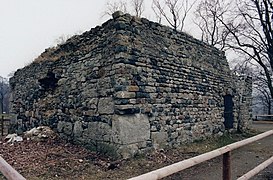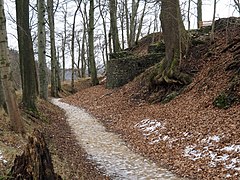Harzburg
| Harzburg | ||
|---|---|---|
|
Harzburg: replica of the foundation walls of a tower |
||
| Alternative name (s): | Great Harzburg | |
| Creation time : | 1065 to 1068 | |
| Castle type : | Hilltop castle | |
| Conservation status: | Wall remains, trench | |
| Standing position : | King, Emperor | |
| Place: | Bad Harzburg | |
| Geographical location | 51 ° 52 '17 " N , 10 ° 34' 3" E | |
| Height: | 485 m above sea level NHN | |
|
|
||
The Harzburg , also known as the Great Harzburg , is the ruin of a former imperial castle on the northern edge of the Harz just above Bad Harzburg in the district of Goslar , Lower Saxony ( Germany ).
The hilltop castle has largely disappeared, only fragments of the foundation walls and the towers as well as the fountain have been preserved.
Geographical location
The ruins of the Höhenburg are located above the village or the Radau valley on the Großer Burgberg (approx. 485 m above sea level ), to which the Burgberg cable car goes.
Neighboring to the north is the Kleine Burgberg ( 436.5 m above sea level ), on which the remains of the Little Harzburg are located, and to the east-south-east lies the Sachsenberg (approx. 546 m above sea level ) with traces of a rampart that may have been used by the rebellious Saxons Siege of the Great Harzburg served (see "History").
Castle description
Of the two different Bergfrieden , the square one has recently been bricked up to a small extent (see photo). The scope of the castle and the few remains of the wall are explained on an information board on site. A section trench carved into the rock divides the castle into an eastern and a western part. Drinking water was supplied to the castle well from a dam in the Kleiner Spüketal, about 1.2 km to the east, through a pipe made of clay pipes and a tunnel. The castle ruins can be visited freely.
In addition to the castle ruins, there is an inn and the 19 m high Canossa column ( 482.8 m above sea level ) from 1877 and a Bismarck elm on the castle grounds.
Castle name
Old names of the castle were in the years 1071 Hartesburg, 1073 Hartesburc, 1073–76 Hartesburg, 1072 Hartesburg, 1073 Hartesburg, 1073 Harzesburg, 1074 castrum Harzeburch, 1076 castello Hartesburg, 1147 Harzesburg and 1180 Hartesburg. The castle name is derived from the name of the Harz low mountain range, which apparently comes from "Hart". A connection with “hard” or Hardt ( Hardthöhe ) for “mountain forest” can be assumed. The place Bad Harzburg means "the Harz castle".
history
Under Henry IV.
The Great Harzburg ( Hartesburg ) was built by King Heinrich IV at a strategically favorable location during the castle building program in Saxony from 1065 to 1068 . Heinrich's master builder was the later Bishop of Osnabrück, Benno II. The castle served to secure the nearby imperial palace of Goslar . Its walls reached up to the steep edge of the mountain cone. At the time, the castle was considered impregnable. Despite its ability to defend itself, the castle was also particularly splendidly equipped. So the castle contained an unusually large, dreiräumigen Palas and a collegiate church , in the Henry many relics left convict. He also built a kind of family crypt at the castle by moving the bones of his brother Konrad II, who died young, and his son Heinrich, who also died at an early age.
At the start of the Saxon War in 1073, Heinrich IV had to flee to the Harzburg together with the imperial insignia from the imperial palace of Goslar. Allegedly 60,000 besiegers followed him and his castle garrison was 300 men. According to legend, the king finally fled through the well of the besieged castle and a secret passage. In the Peace of Gerstungen on February 2, 1074, Heinrich had to agree to the razing of his castles, including the Harzburg. However, he delayed the destruction and only had the walls and towers of the Harzburg put down while the buildings remained standing. The Harzburg was then plundered and completely destroyed by angry farmers in the area in the spring of 1074. The collegiate church was not spared and the royal family crypt was desecrated. This provided the reason for Heinrich to act again with all severity against the rebellious Saxons and so the defeat of the rebellious Saxons in the battle of Homburg an der Unstrut took place on June 9, 1075 .
Among the Hohenstaufen and Guelphs

Under Emperor Friedrich I , the reconstruction took place until 1180 and was completed by Emperor Otto IV , who died in the castle in 1218. The Harzburg lost its immediate function as an imperial castle because Emperor Otto IV had ordered the handover of the imperial insignia to the Staufer side . In 1222, the Harzburg was given the name castrum imperiale , although the character of the castle as an imperial castle was largely preserved due to the castle fiefdom system that was intact until it was pledged in 1269 and the still existing Harzburg seats that could be leaned against.
Another story
After that there were frequent changes of ownership. In the 15th century it was passed on to three von Schwicheldt brothers, who converted it into a robber baron's castle . The importance of the complex steadily decreased, which resulted in a slow decline. A reconstruction planned in the 16th century was not carried out because of the high costs. During the Thirty Years War , the castle changed crew several times, but remained undamaged. Since this type of fortification had become insignificant due to the changed warfare, the demolition of the remaining ruins began in 1650. The castle complex has not existed since then, apart from a few remains of the wall and the fountain. The urban settlement "Neustadt" at the foot of the Großer Burgberg took over the castle name.
Picture gallery
Section trench and bridge, Krodofigur
literature
- Maria Keibel-Meier: The Harzburg ( large architectural monuments , issue 327) . Munich / Berlin 1980.
- EJG Leonhard: The Harzburg and its history . Fleckeisensche Buchhandlung, Helmstedt 1825.
- Wolf-Dieter Steinmetz: History and archeology of the Harzburg under Saliern, Staufern and Welfen 1065–1254 . Bad Harzburg 2001.
- Friedrich Stolberg : Fortifications in and on the Harz from early history to modern times . Lax, Hildesheim 1968.
- Heinrich Spier: The history of the Harzburg . Harzburg Antiquities and History Association, Bad Harzburg 1985.
- Ernst Andreas Friedrich : The ruins of the Harzburg , pp. 54–56, in: If stones could talk , Volume II, Landbuch-Verlag, Hanover 1992, ISBN 3-7842-0479-1 .
- Maria Keibel-Meier: The Harzburg. On the history, the excavations and results in: excavations in Lower Saxony. Archaeological monument preservation 1979–1984. Stuttgart 1985.
- Thomas Moritz and Philipp Matschoß: Findings, measurements and reconstruction using the example of the Great Harzburg and Plesse Castle in: Archeology in Lower Saxony , Volume 16, Isensee Verlag Oldenburg, 2013. ISBN 3-89995-987-6
- Hans Adolf Schultz : Burgen und Schlösser des Braunschweiger Land , Braunschweig 1980, Die Reichsfeste Harzburg , pp. 96-101, ISBN 3-87884-012-8
- Horst Woick: The secrets of the castle fountain on the Harzburg (= general Harz mountain calendar ). Paper plane, Clausthal-Zellerfeld 2020, ISBN 978-3-86948-710-6 , p. 51-53 .
Web links
- Entry by Stefan Eismann zu Harzburg in the scientific database " EBIDAT " of the European Castle Institute
- Reconstruction drawing in the medieval state
- Harzburg , on burgenwelt.de
- Förderverein Historischer Burgberg Bad Harzburg eV , on die-harzburg.de
- Description of the castle in the Braunschweig-Ostfalen region
Individual evidence
- ↑ Height of the Großer Burgberg according to the topographical map ( memento of the original from September 4, 2012 in the Internet Archive ) Info: The archive link was inserted automatically and has not yet been checked. Please check the original and archive link according to the instructions and then remove this notice. , on natur-erleben.niedersachsen.de
- ↑ a b Location height Canossa column and mountain height Kleiner Burgberg according to the German basic map (M = 1: 5,000, topographical map), Lower Saxony State Surveying Office, Ed. Georg Westermann Verlag, Braunschweig, 1976; at that time was still sea level (MSL)
- ↑ Information board at the Sachsenbrunnen, exhibition on the Harzburg in the local museum "Alte Remise" .
- ^ Jürgen Udolph (research): The "place name researcher". (No longer available online.) In: Internet site NDR 1 Lower Saxony . Archived from the original on November 27, 2015 ; accessed on August 4, 2019 .
- ↑ Joachim Lehrmann : Robber barons between Heide, Harz and Weser , Lehrte 2007, Lehrmann-Verlag, ISBN 978-3-9803642-6-3 , pp. 262–268.







